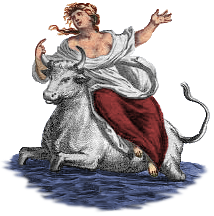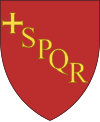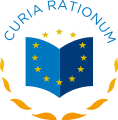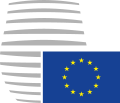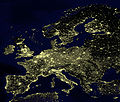Portal:European Union
Introduction
The European Union (EU) is a supranational political and economic union of 27 member states that are located primarily in Europe. The Union has a total area of 4,233,255 km2 (1,634,469 sq mi) and an estimated total population of over 449 million. The EU has often been described as a sui generis political entity combining the characteristics of both a federation and a confederation. Containing 5.8% of the world population in 2020, EU member states generated a nominal gross domestic product (GDP) of around US$16.6 trillion in 2022, constituting approximately one sixth of global nominal GDP. Additionally, all EU states except Bulgaria have a very high Human Development Index according to the United Nations Development Programme. Its cornerstone, the Customs Union, paved the way to establishing an internal single market based on standardised legal framework and legislation that applies in all member states in those matters, and only those matters, where the states have agreed to act as one. EU policies aim to ensure the free movement of people, goods, services and capital within the internal market; enact legislation in justice and home affairs; and maintain common policies on trade, agriculture, fisheries and regional development. Passport controls have been abolished for travel within the Schengen Area. The eurozone is a group composed of the 20 EU member states that have fully implemented the economic and monetary union and use the euro currency. Through the Common Foreign and Security Policy, the union has developed a role in external relations and defence. It maintains permanent diplomatic missions throughout the world and represents itself at the United Nations, the World Trade Organization, the G7 and the G20. Due to its global influence, the European Union has been described by some scholars as an emerging superpower. In 2012, the EU was awarded the Nobel Peace Prize. The United Kingdom became the only member state to leave the EU, in 2020; ten countries are aspiring or negotiating to join it. (Full article...) Selected article The euro (currency sign: €; currency code: EUR) is the official currency of the European Union (EU). Nineteen member states have adopted it, known collectively as the Eurozone (Austria, Belgium, Cyprus, Estonia, Finland, France, Germany, Greece, Ireland, Italy, Latvia, Lithuania, Luxembourg, Malta, the Netherlands, Portugal, Slovakia, Slovenia, Spain). The currency is also used in five further countries with formal agreements and six other countries without such agreements. Hence it is the single currency for over 320 million Europeans. Including areas using currencies pegged to the euro, the euro directly affects close to 500 million people worldwide. With more than €610 billion in circulation as of December 2006 (equivalent to US$802 billion at the exchange rates at the time), the euro is the currency with the highest combined value of cash in circulation in the world, having surpassed the U.S. dollar (USD). Taking official estimates of 2007 GDP, the Eurozone is the largest economy in the world by March 2008 after the USD/EUR exchange rate surpassed 1.56. The euro was introduced to world financial markets as an accounting currency in 1999 and launched as physical coins and banknotes on 1 January 2002. It replaced the former European Currency Unit (ECU) at a ratio of 1:1. The euro is managed and administered by the Frankfurt-based European Central Bank (ECB) and the Eurosystem (composed of the central banks of the euro zone countries). As an independent central bank, the ECB has sole authority to set monetary policy. The Eurosystem participates in the printing, minting and distribution of notes and coins in all member states, and the operation of the Eurozone payment systems. Selected picturePhotograph credit: Arild Vågen Vaxholm Fortress is a historic fortification on the island of Vaxholmen in the Stockholm archipelago just east of the Swedish town of Vaxholm. The first structure, a wooden blockhouse, was constructed by King Gustav I in 1548 as a defensive structure and customs post at this strategic site on the sea approach to Stockholm. It was replaced by a round stone tower during John III's reign. The present buildings date to 1833; their design was inspired by ideas on fortifications propounded by French engineers the marquis de Montalembert and Lazare Carnot. The fortress has been listed as a state monument since 1935 and now houses the Vaxholm Fortress Museum.
Did you know?...that "Nocturne" is the Eurovision Song Contest winner with the fewest words, the Norwegian language original having only 25?  ...that the Eastgate Clock (pictured) in Chester is the second most photographed timepiece in the United Kingdom, after Big Ben? ...that "Kinek mondjam el vétkeimet?" received three perfect scores at the start of voting in the Eurovision Song Contest 1994 before ultimately coming in fourth, making Hungary the only debuting nation to lead the voting? Selected cityRome is the capital of Italy and of its region, called Lazio. It is located across the confluence of the Tiber and Aniene rivers. It was once the capital of the Roman Empire, the most powerful, largest and longest lasting empire of classical Western civilization. The Vatican, a sovereign enclave within Rome, is the seat of the Roman Catholic Church and the home of the Pope. Rome is the largest comune in Italy and it is also one of the largest European capital cities in land area, with an area of 1,285 square kilometers. Within the city limits, the population is about 2.5 million; almost 3.8 million live in the urbanised area of Rome, as represented by the province of Rome, making it second in population to Milan. With a gross domestic product of €97 billion in the year 2005, Rome produced 6.7% of Italy's GDP. General imagesThe following are images from various European Union-related articles on Wikipedia.
TopicsFeatured contentFeatured articles
Featured lists
Featured contentGood articles
CategoriesRelated portalsAssociated WikimediaThe following Wikimedia Foundation sister projects provide more on this subject:
Discover Wikipedia using portals |



